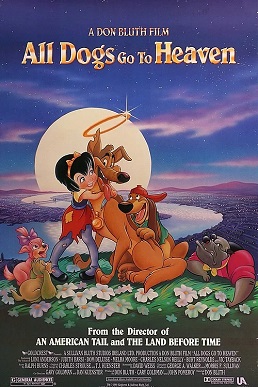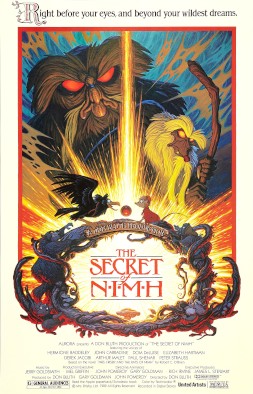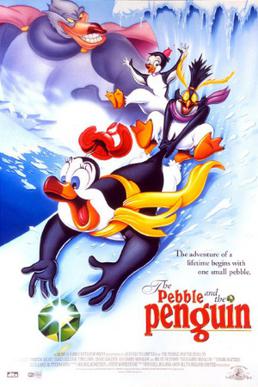Modern animation in the United States from the late 1980s to the early 2000s is frequently referred to as the renaissance age of American animation. During this period, many large American entertainment companies reformed and reinvigorated their animation departments, following the dark age, and the United States had an overall profound effect on animation globally.

Anastasia is a 1997 American animated musical historical fantasy adventure comedy-drama film produced and directed by Don Bluth and Gary Goldman from a screenplay by Susan Gauthier, Bruce Graham, and the writing team of Bob Tzudiker and Noni White. The film stars the voices of Meg Ryan, John Cusack, Kelsey Grammer, Christopher Lloyd, Hank Azaria, Bernadette Peters, Kirsten Dunst, and Angela Lansbury. Loosely based on the legend of the Grand Duchess Anastasia Nikolaevna of Russia, youngest daughter of the last Russian Tsar, Nicholas II, and set in an alternate version of 1926, the film follows eighteen-year-old amnesiac orphan, Anya, who, hoping to find some trace of her past, sides with two con men who wish to pass her off as the Grand Duchess to Anastasia's paternal grandmother, Dowager Empress Maria Feodorovna, amidst the rumors that the Grand Duchess had escaped the execution of the royal family. The film shares its plot with the 1956 film of the same name, which in turn was based on a play by Marcelle Maurette. Unlike those treatments, this version adds a magically empowered Grigori Rasputin as the antagonist.

All Dogs Go to Heaven is a 1989 animated musical fantasy comedy-drama film directed by Don Bluth and co-directed by Gary Goldman and Dan Kuenster. Set in New Orleans in 1939, it tells the story of Charlie B. Barkin, a German Shepherd that is murdered by his former friend, Carface Carruthers. Charlie escapes from Heaven to return to Earth where his best friend, Itchy Itchiford, still lives, in order to take revenge on Carface. Instead, he ends up befriending a young orphan girl named Anne-Marie. In the process, Charlie learns an important lesson about kindness, friendship and love.

The Secret of NIMH is a 1982 American animated fantasy adventure film directed by Don Bluth in his directorial debut and based on Robert C. O'Brien's 1971 children's novel, Mrs. Frisby and the Rats of NIMH. The film features the voices of Elizabeth Hartman, Peter Strauss, Arthur Malet, Dom DeLuise, John Carradine, Derek Jacobi, Hermione Baddeley, and Paul Shenar. It was produced by Bluth's production company Don Bluth Productions in association with Aurora Productions.

Donald Virgil Bluth is an American filmmaker, animator, and author. He is best known for directing the animated films The Secret of NIMH (1982), An American Tail (1986), The Land Before Time (1988), All Dogs Go to Heaven (1989), Anastasia (1997), and Titan A.E. (2000), for his involvement in the LaserDisc game Dragon's Lair (1983), and for competing with former employer Walt Disney Productions during the years leading up to the films that became the Disney Renaissance. He is the older brother of illustrator Toby Bluth.

The Fox and the Hound is a 1981 American animated buddy drama film produced by Walt Disney Productions and loosely based on the 1967 novel of the same name by Daniel P. Mannix. It tells the story of the unlikely friendship between a red fox named Tod and a hound named Copper, as they struggle against their emerging instincts and the realization that they are meant to be adversaries.

Gary Wayne Goldman is an American film producer, director, animator, writer and voice actor. He is known for working on films with Don Bluth such as All Dogs Go to Heaven for his directorial debut, Anastasia, An American Tail, and The Land Before Time. He was an animator at Disney before working at Sullivan Bluth Studios with Bluth.

Fox Animation Studios was an American animation production company owned by 20th Century Fox and located in Phoenix, Arizona. After six years of operation, the studio was shut down on June 26, 2000, ten days after the release of its final film, Titan A.E.. Most of the Fox Animation Studios library was acquired by Disney on March 20, 2019. Anastasia is the studio's most critically praised and commercially successful film, as well as the most commercially successful film by Don Bluth.

20th Century Animation, Inc. is an American animation studio located in Century City, Los Angeles. Formed in 1994, it is organized as a division and label of 20th Century Studios, a subsidiary of the Walt Disney Studios, and is tasked with producing animated feature-length films. At one point, 20th Century Animation had two subsidiaries: Fox Animation Studios, which was shut down on June 26, 2000, and Blue Sky Studios, which was closed on April 10, 2021. Walt Disney Studios Home Entertainment distributes the films produced by 20th Century Animation in home media under the 20th Century Home Entertainment banner.

Banjo the Woodpile Cat is a 1979 American animated short film directed by Don Bluth. It follows the story of Banjo, an overly curious and rebellious kitten who, after getting into trouble for falling from a house to see if he could land on his feet, runs away from his woodpile home in his owners' farm in Payson, Utah by catching a truck to Salt Lake City. Produced on a shoestring budget, and created in Bluth's garage, the film took four years to make and it was the first production of Don Bluth Productions, later Sullivan Bluth Studios. It premiered theatrically on November 16, 1979, and at the USA Film Festival one year later on March 28, 1980. It was released on DVD by 20th Century Fox Home Entertainment on May 20, 2014.
Don Bluth Entertainment was an Irish-American animation studio established in 1979 by animator Don Bluth. Bluth and several colleagues, all of whom were former Disney animators, left Disney on September 13, 1979, to form Don Bluth Productions, later known as the Bluth Group. This studio produced the short film Banjo the Woodpile Cat, the feature film The Secret of NIMH, a brief animation sequence in the musical Xanadu, and the video games Dragon's Lair and Space Ace. Bluth then co-founded Sullivan Bluth Studios with American businessman Gary Goldman, John Pomeroy and Morris Sullivan in 1985.
John Foster Pomeroy is an American animator who has worked for several major studios, including Walt Disney Animation Studios and Sullivan Bluth Studios. He has also worked as producer, and screenwriter on several animated feature films.

Anya is a character in 20th Century Fox's animated film Anastasia (1997). An eighteen-year-old Russian orphan with amnesia, Anya travels to Paris, France, in hopes of re-discovering her past and family, collaborating with a pair of con artists who scheme to use her likeness to Russia's Imperial family to win a lucrative reward. Although largely fictionalized, the character is loosely based on two historical figures: Grand Duchess Anastasia Nikolaevna of Russia, the youngest daughter of Tsar Nicholas II, and Anna Anderson, an imposter famous for claiming to be the Grand Duchess. Plot elements from the film Anastasia (1956), in which the title character is played by actress Ingrid Bergman, served as a primary source of inspiration for Anya.
Morris Francis Sullivan was an American businessman who co-founded the Sullivan Bluth Studios with three former Disney animators. Sullivan Bluth Studios employed approximately 400 people at the peak of its success. Under Sullivan's direction, the former animation studio created such films as The Land Before Time and An American Tail.

The Pebble and the Penguin is a 1995 American independent musical-comedy-adventure film animated film directed by Don Bluth and Gary Goldman. The film stars the voices of Martin Short, Jim Belushi, Tim Curry, and Annie Golden. Based on the true life mating rituals of the Adélie penguins in Antarctica, the film focuses on a timid, stuttering penguin named Hubie who tries to impress a beautiful penguin named Marina by giving her a pebble that fell from the sky and keep her from the clutches of an evil penguin named Drake who wants Marina for himself.
Jeffrey James Varab is a leading animator and visual effects artist and one of the pioneers of 3D computer animation. His work on the 1995 film Casper marked the first fully computer-rendered lead character in a feature film, beating Woody and Buzz Lightyear of the fully computer-animated Toy Story by six months.
Since the 1960s, The Marvel Comics superhero, Thor has appeared in a wide variety of media outside of comic books including films, television programs and video games.
Dragon's Lair is a video game franchise created by Rick Dyer. The series is notable for its Western animation-style graphics and complex decades-long history of being ported to many platforms. It has been adapted into television and comic book series.

20th Century Family is a division of 20th Century Studios which produces family-friendly films and television programs. Besides theatrical films, the division oversees mixed media, family animated holiday television specials based on film properties, and film features based on TV shows.











